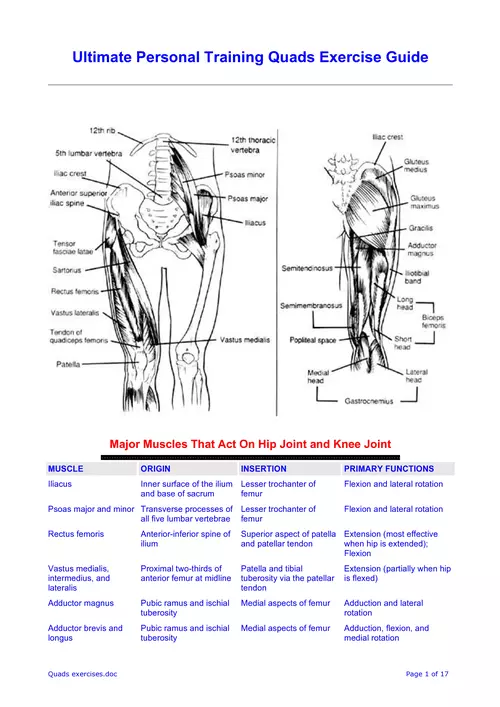
Ultimate Personal Training Quads Exercise Guide
Wall Squat.
adsPart of the document
Quads exercises.doc Page 1 of 17 Ultimate Personal Training Quads Exercise Guide Major Muscles That Act On Hip Joint and Knee Joint MUSCLE ORIGIN INSERTION PRIMARY FUNCTIONS Iliacus Inner surface of the ilium and base of sacrum Lesser trochanter of femur Flexion and lateral rotation Psoas major and minor Transverse processes of all five lumbar vertebrae Lesser trochanter of femur Flexion and lateral rotation Rectus femoris Anterior-inferior spine of ilium Superior aspect of patella and patellar tendon Extension (most effective when hip is extended); Flexion Vastus medialis, intermedius, and lateralis Proximal two-thirds of anterior femur at midline Patella and tibial tuberosity via the patellar tendon Extension (partially when hip is flexed) Adductor magnus Pubic ramus and ischial tuberosity Medial aspects of femur Adduction and lateral rotation Adductor brevis and longus Pubic ramus and ischial tuberosity Medial aspects of femur Adduction, flexion, and medial rotation
Quads exercises.doc Page 2 of 17 Barbell Deadlift Exercise Data Main Muscle Worked: Quadriceps Other Muscles Worked: Hamstrings,Calves,Glutes Equipment: Barbell Mechanics Type: Compound What NOT To Do: Tips: Think of a deadlift as a squat, only the bar is in your hands rather than on your back. The Stance: Approach the loaded barbell and assume a stance about as wide as your own shoulders while gripping the bar such that the inner aspects of your arms are slightly outside of your thighs. Another way to determine your optimal deadlift foot placement is to jump down from a box which is half your own height and "stick" the landing. Now look at your feet...this will approximate your ideal stance width and degree of foot turn-out. Feet and Shin Position: Feet should point straight forward or turned out to a 25 degree angle at most. The best foot angle is one which provides the least amount of hip and knee restriction when you lower the hips in preparation to lift, so don't be afraid to experiment a bit. The shins should be two to three inches from the bar and then when you actually bend down and lower your hips in preparation to lift, the shins will touch the bar. Most of the weight will be on the heels of the feet. This facilitates maximal contribution of the glutes and hamstrings. During the ascent, the bar will travel as close to the leg and shins as possible. Ideally, wear cotton sweat pants or track pants with long socks to protect your shins. Hand Position: A "reverse grip" should be used when deadlifting. This means that one hand will be supinated (palm faces you) and the other pronated (palm facing away). This will help keep the bar in your hand. If grip strength is not one of your training targets, feel free to use wrist straps with a conventional grip. Hold the bar high up on the palm to compensate for any roll of the bar when pulling the weight up. Generally, the grip should start with the index finger and the little finger bordering the knurling in the middle of the bar.
Quads exercises.doc Page 3 of 17 Head Placement and Eye Contact: The entire spine should remain neutral, which means you look neither up nor down, but instead, the head follows the body, almost like you're wearing a cervical cast on your neck. It's OK for the head to be SLIGHTLY up (this tends to improve muscular contraction of the low back muscles) but in all cases, the lift must start with the hips down, the entire spine neutral, and the feet flat on the floor. The Ascent: As you stand up with the weight, imagine pushing the earth away from you with your feet. When viewed from the side, your hips and shoulders should ascend together; if the hips rise before the shoulders, it means you're using your back rather than your legs. If this happens, reduce the weight until you can perform the lift correctly and add more specific quad-strengthening exercises to your program. The Lockout: Competitive powerlifters are required to demonstrate control over the weight by standing up and then extending the hips forward in an exaggerated manner. If you're NOT a competitive lifter, simply stand up with the weight without this exaggerated maneuver. The Descent: Simply return the bar to the floor, under control, by reversing the technique you used to lift the weight. Barbell Full Squat Exercise Data Main Muscle Worked: Quadriceps Other Muscles Worked: Hamstrings,Calves,Glutes Equipment: Barbell Mechanics Type: Compound Tips: Position a barbell on the back of the shoulders and grasp bar to the sides. Put your feet at shoulder width with your to es and knees sl ightly poin ted outwards. Desce nd until knees and hips are fully bent. Extend knees and hips until legs are straight. Return and repeat. Some people believe this is damagine to your knee, but others believe it is a great exercise. Can also be done with dumbbells in your hands instead or on the Smith machine. Barbell Hack Squat Exercise Data Main Muscle Worked: Quadriceps Other Muscles Worked: Forearms,Hamstrings,Calves Equipment: Barbell Mechanics Type: Compound


